
امروز سه شنبه ۲۵ اردیبهشت ۱۴۰۳
اگر به یک وب سایت یا فروشگاه رایگان با فضای نامحدود و امکانات فراوان نیاز دارید بی درنگ دکمه زیر را کلیک نمایید.
ایجاد وب سایت یادسته بندی سایت
محبوب ترین ها
پرفروش ترین ها
پر فروش ترین های فورکیا
 پکیج حرفه ای کسب درآمد میلیونی ( تضمینی و تست شده)
پکیج حرفه ای کسب درآمد میلیونی ( تضمینی و تست شده) دانلود طرح لایه باز اعلامیه ترحیم (11) (دانش یاران)
دانلود طرح لایه باز اعلامیه ترحیم (11) (دانش یاران) دانلود "کتاب صدای خود را آزاد کنید"pdf+فایلهای تمرینی
دانلود "کتاب صدای خود را آزاد کنید"pdf+فایلهای تمرینی پکیج صداسازی متود CVT
پکیج صداسازی متود CVT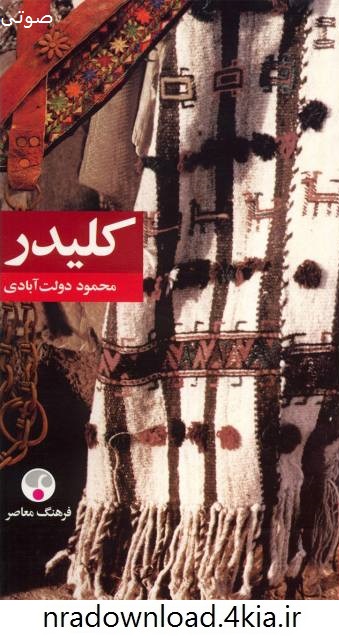 دانلود کتاب صوتی کلیدر (مجموعه کامل)
دانلود کتاب صوتی کلیدر (مجموعه کامل)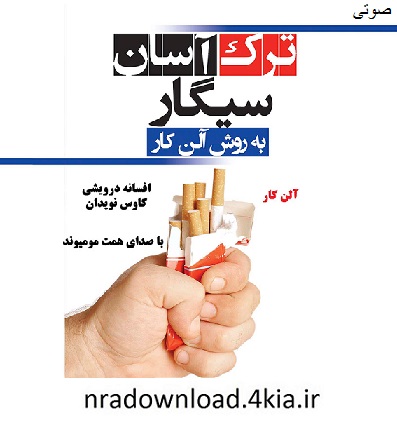 دانلود کتاب صوتی ترک آسان سیگار
دانلود کتاب صوتی ترک آسان سیگار نمونه سوالات انباردار رشته حسابداری فنی حرفه ای | کاردانش با جواب
نمونه سوالات انباردار رشته حسابداری فنی حرفه ای | کاردانش با جواب کتاب معلم Nuevo prisma libro de profesor (A2)
کتاب معلم Nuevo prisma libro de profesor (A2) کتاب آموزش زبان آلمانی A-Grammatik به همراه پاسخ نامه و فایل های صوتی کتاب
کتاب آموزش زبان آلمانی A-Grammatik به همراه پاسخ نامه و فایل های صوتی کتاب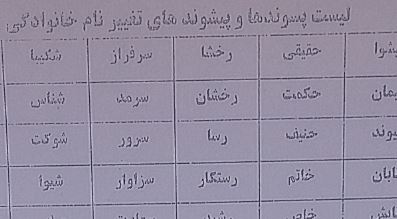 لیست پسوند و پیشوند فامیلی مورد تایید سازمان ثبت احوال
لیست پسوند و پیشوند فامیلی مورد تایید سازمان ثبت احوال کسب درآمد اینترنتی 300000 تومان در خانه در کمتر از 30 دقیقه
کسب درآمد اینترنتی 300000 تومان در خانه در کمتر از 30 دقیقه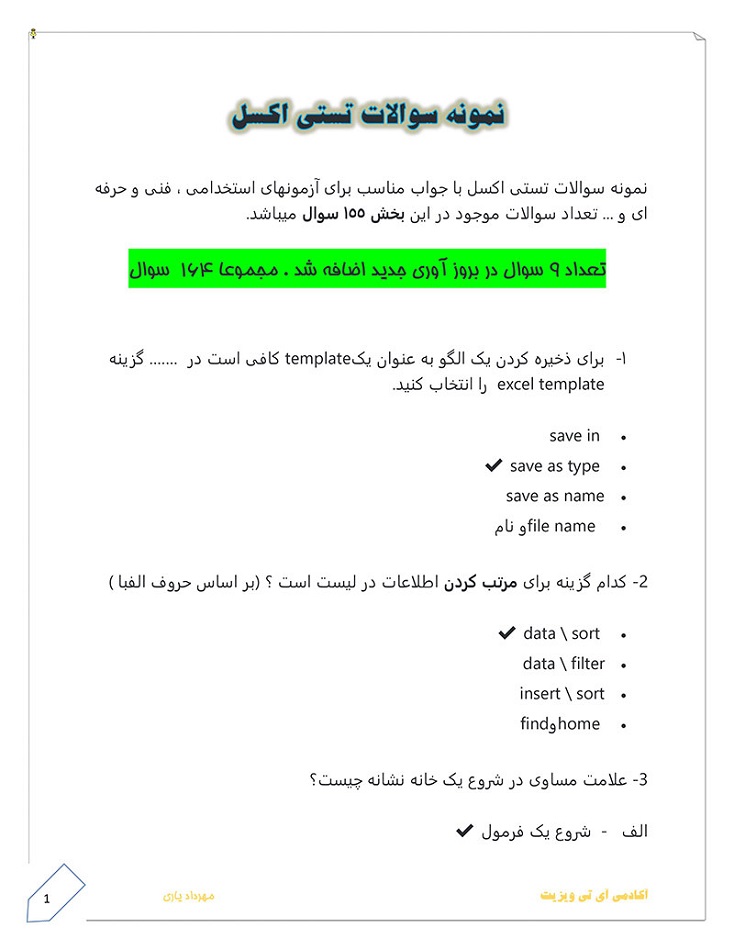 نمونه سوالات اکسل همراه با جواب pdf
نمونه سوالات اکسل همراه با جواب pdf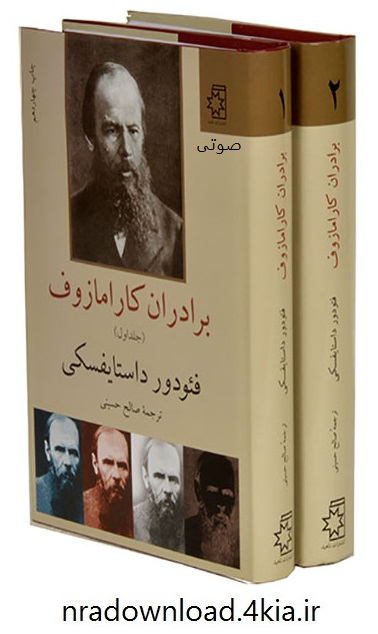 دانلود کتاب صوتی برادران کارامازوف (جلد اول و دوم بصورت کامل)
دانلود کتاب صوتی برادران کارامازوف (جلد اول و دوم بصورت کامل) ترمینولوژی حقوق دکتر جعفر لنگرودی
ترمینولوژی حقوق دکتر جعفر لنگرودی نمونه اجاره نامه مسکونی تجاری همراه با اصل فایل(دانش یاران)
نمونه اجاره نامه مسکونی تجاری همراه با اصل فایل(دانش یاران)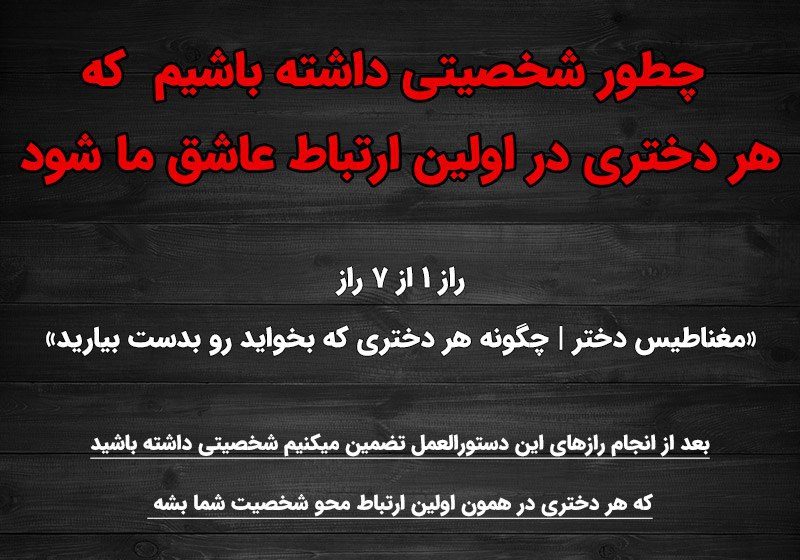 کتاب مغناطیس جذب دختر
کتاب مغناطیس جذب دختر کتاب صوتی هنر شفاف اندیشدن با صدای عادل فردوسی پور
کتاب صوتی هنر شفاف اندیشدن با صدای عادل فردوسی پور علائم گرافیکی تحلیل سایت فتوشاپ
علائم گرافیکی تحلیل سایت فتوشاپ دانلود کتاب صوتی جان شیفته (مجموعه کامل)
دانلود کتاب صوتی جان شیفته (مجموعه کامل) کتاب حقوق مدنی 6 دکتر ناصر کاتوزیان
کتاب حقوق مدنی 6 دکتر ناصر کاتوزیان آموزش فعال کردن چشم سوم
آموزش فعال کردن چشم سوم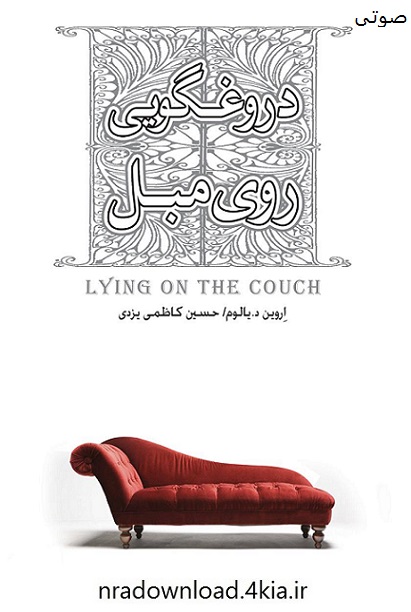 دانلود کتاب صوتی دروغگویی روی مبل
دانلود کتاب صوتی دروغگویی روی مبل دیتابیس فرهنگ لغت دهخدا
دیتابیس فرهنگ لغت دهخدا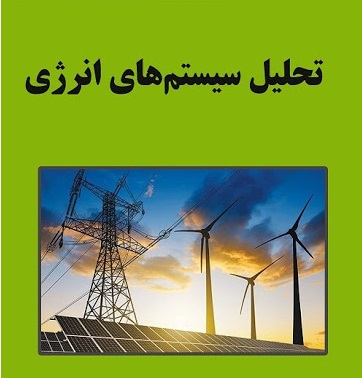 جزوات و حل تمرینات و نمونه سوالات امتحانی درس تحلیل سیستم های انرژی رشته های فنی مهندسی
جزوات و حل تمرینات و نمونه سوالات امتحانی درس تحلیل سیستم های انرژی رشته های فنی مهندسی پاورپوینت فصل پانزدهم تئوری حسابداری (جلد 2) تألیف دکتر ساسان مهرانی، دکتر غلامرضا کرمی، مهتاب جهرومی و سیدمصطفی سیدحسینی
پاورپوینت فصل پانزدهم تئوری حسابداری (جلد 2) تألیف دکتر ساسان مهرانی، دکتر غلامرضا کرمی، مهتاب جهرومی و سیدمصطفی سیدحسینی ساخت ربات های تریدر (معامله گر) با نرم افزار Forex Strategy Builder بدون نیاز به هیچ علم تکنیکال یا علم برنامه نویسی
ساخت ربات های تریدر (معامله گر) با نرم افزار Forex Strategy Builder بدون نیاز به هیچ علم تکنیکال یا علم برنامه نویسی کتاب آموزش خیاطی انواع لباس مجلسی
کتاب آموزش خیاطی انواع لباس مجلسی دانلود کتاب صوتی انسان خردمند + pdf
دانلود کتاب صوتی انسان خردمند + pdfپر بازدید ترین های فورکیا
 فروش فیلتر بورسی استریکلی فقط 75 هزار تومان
فروش فیلتر بورسی استریکلی فقط 75 هزار تومان کسب درآمد اینترنتی 300000 تومان در خانه در کمتر از 30 دقیقه
کسب درآمد اینترنتی 300000 تومان در خانه در کمتر از 30 دقیقه کسب درآمد روزانه حداقل یک میلیون تومان ! کاملا حلال و واقعـی !!
کسب درآمد روزانه حداقل یک میلیون تومان ! کاملا حلال و واقعـی !! مجموعه ی آموزش تعمیر لامپ کم مصرف (از مبتدی تا پیشرفته)
مجموعه ی آموزش تعمیر لامپ کم مصرف (از مبتدی تا پیشرفته) کسب و کار اینترنتی در منزل
کسب و کار اینترنتی در منزل آموزش برنامه نویسی آردوینو
آموزش برنامه نویسی آردوینو آموزش رایگان کسب درآمد از سایت الیمپ ترید ( olymp trade )
آموزش رایگان کسب درآمد از سایت الیمپ ترید ( olymp trade ) دانلود نمونه فاکتور آماده با فرمت ورد - اکسل و عکس
دانلود نمونه فاکتور آماده با فرمت ورد - اکسل و عکس آموزش ساخت بازی بدون دانش برنامه نویسی و طراحی سه بعدی مبتدی تا پیشرفته با نرم افزار
آموزش ساخت بازی بدون دانش برنامه نویسی و طراحی سه بعدی مبتدی تا پیشرفته با نرم افزار اموزش کسب درامد از اینترنت روزانه ۳میلیون تومان تضمینی و تست شده
اموزش کسب درامد از اینترنت روزانه ۳میلیون تومان تضمینی و تست شده درامدزایی در خواب! (تعجب نکنید! بخوانید)
درامدزایی در خواب! (تعجب نکنید! بخوانید) مدار داخلی واکی تاکی(اموزش ساخت)
مدار داخلی واکی تاکی(اموزش ساخت) کتاب افزایش ممبر کانال تلگرام
کتاب افزایش ممبر کانال تلگرام دانلود100% رایگان نرم افزار تبلیغات در تلگرام + آموزش کامل و فیلم آموزشی
دانلود100% رایگان نرم افزار تبلیغات در تلگرام + آموزش کامل و فیلم آموزشی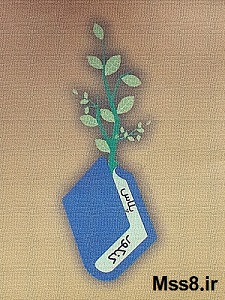 روش اصلی موفقیت در کنکور و آزمون ها(پزشکی، حقوق، مهندسی، نمونه و تیزهوشان) با پکیج کنکورپلاس
روش اصلی موفقیت در کنکور و آزمون ها(پزشکی، حقوق، مهندسی، نمونه و تیزهوشان) با پکیج کنکورپلاس چگونه هر شخصی را عاشق خود کنیم ارزان
چگونه هر شخصی را عاشق خود کنیم ارزان برنامه ساز اندروید و کسب درآمد بالا
برنامه ساز اندروید و کسب درآمد بالا ثروتمند شدن حق شماست !! امتحان کنید!!!
ثروتمند شدن حق شماست !! امتحان کنید!!! ساده ترین و پردرآمد ترین کسب و کار در اینترنت تا لحظه درآمد با شما همراه خواهیم بود
ساده ترین و پردرآمد ترین کسب و کار در اینترنت تا لحظه درآمد با شما همراه خواهیم بود حل تمارین دینامیک سازه
حل تمارین دینامیک سازه کسب درآمد میلیونی از وبلاگ
کسب درآمد میلیونی از وبلاگ دانلودپکیج ربات فالوور و لایک نامحدود و رایگان اینستاگرام(فوق حرفه ای)
دانلودپکیج ربات فالوور و لایک نامحدود و رایگان اینستاگرام(فوق حرفه ای) مجموعه "صفر تا صد راه اندازی کارگاه جوراب بافی"
مجموعه "صفر تا صد راه اندازی کارگاه جوراب بافی" کسب در آمد میلیونی از اینترنت (نسخه ی پیشرفته) 80 درصد تخفیف
کسب در آمد میلیونی از اینترنت (نسخه ی پیشرفته) 80 درصد تخفیف چگونه هر کسی را عاشق خود کنیم ؟
چگونه هر کسی را عاشق خود کنیم ؟ اندیکاتور R & S جهت کسب درآمد از سایت الیمپ ترید
اندیکاتور R & S جهت کسب درآمد از سایت الیمپ ترید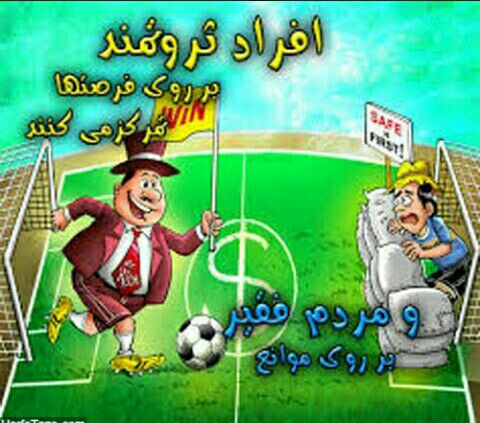 کسب درآمد اینترنتی و دائمی به صورت صفر تا صد کار
کسب درآمد اینترنتی و دائمی به صورت صفر تا صد کارپیوند ها
Happiness and society:
An analyze of the social conditions, affecting the happiness of students in Iran
Abstract:
Today, the subject of happiness is one of the most important issues in modern societies. Because, human development, depends on efficient use of manpower and paying attention to it in human societies. Happiness and social vitality may be an indicator of social health of a community. Because the man with a sense of exhilaration, can be innovative, creative and efficient. The present survey, by using investigation method aims to study social fields, which are effective on happiness, but does not neglect the role of psychological factors. Statistical people in this research are, all students of Islamic Azad university of Kerman branch in the year 2014, equal to 16403 members. We used Cochran formula, which has been estimated a sample of 400 fellows and also the Oxford questionnaire to evaluate the happiness and joy. Theoretical framework is based on the ideas of MAX HALER and MARKAZ HADLER, BELBUM and BARHIR, SHINEZ, BERGEZMA, was figured in section of effective factors on creating happiness and based on it, some assumptions were set, then by using AMOS 16 software, path diagram was fitted, results showed that, social factors just like: hope to the future, social class and sense of relative deprivation are affecting happiness through their effectiveness on psychological factors and individuals (0/24). And direct effectiveness of these variables on happiness in the present research is not significant. But on the other hand, direct impact of psychological factors such as openness, interest in others and family status on happiness is positive (1/77) and strong.
Key words: happiness, family status, interest in others, social development.
Introduction and expression of the problem:
One of the issues, if properly addressed, can lead to the expansion of mind, mobility, individual comfort and social comfort, in urban and rural areas and facilitate the process of growth and social development. The debate is about joy and happiness. Majority of the humans and maybe all of them, want to be happy. Because man from olden days, wanted to live better (KAMYAB and colleagues, 108, 2009)
What tools will provide his satisfaction? And by what mechanism, he can breathe with joy and takes more interest? While the results of different researches indicates that cultural pressures (KARAMI, NOURI, 2002) and economical pressure (MIR SHAH, JAFARI, 2002), (AKBARZADEH and colleagues, 2011), social pressure (KARAMI, NOURI, 20020), political pressure (BENDELOW and ARGYLE, 1997), family and psychological pressure (HEZAR JARIBI and coworkers, 2009), (KAMYAB and companions, 2009), and population pressure. The mentioned pressures can reduce the satisfaction and happiness of people in urban areas (AKBARZADEH and colleagues, 2011). Therefore, for most of the people, happiness remained hopelessly and out of access. While, results of the studies are pointing to this matter that happiness (as a factor of mind and mental), itself can be cure for diseases and physical pain (ALIPOUR and colleagues, 2000), OKUN and companions, 1984: 111), while, lack of happiness and joy in society, brings lot of negative results (KAMYAB and coworkers, 2009), just like: depression, pessimism, negative assessment of events, apathy toward work, lack of consciousness, addiction to drugs, social disorders,
Prevalent of violence in social relations, divorce and interest in foreign culture and outsider.
In transnational studies on happiness, MINCO (2009), quoted by AKBARZADEH and colleagues (2013), and has done a research at international level on the happiness and in that, measured the happiness index of the countries. And showed the level of happiness in Iran, during the 1997-2007 among 97 countries was in class 56, which is lower than the average (MINCO, 2009:163, quoted by AKBARZADEH and colleagues, 2013).
On the basis of another theory, which measured the happiness feeling in different countries in a period of 10 years (from 1995-2005), (the level of happiness feeling was calculated in variable dimension of zero to ten), level of happiness in Iran was equal to 6, its criterion deviation was equal to 2/7, and class of Iran among 95 countries which were under study was 51-53. Hope for life in Iran was 69/4, expecting a happy life in years of hope to live was 41/4 was estimated. and in case of rate of happy feelings and expecting a happy life in years of hope to live in compare with some countries like Denmark, Island, Canada, Ireland, Netherland, Germany, Britain, Italy, Indonesia, Japan, Portugal etc. was very low. And in terms of inequality of happiness feeling in the said countries had allocated a higher figure to itself (Eur. NI. report, 2006). By evaluating such figures, a question comes to our mind, with attention to the fields and conditions, which create happy feelings, why Iran and Iranians, in compare to some other countries are allocated to themselves less figure of happiness. Unfortunately, the results of many researches regarding happiness of students `happiness, indicates that Iranian students have passive mood and are not succulent.
This mood belongs to various problems of society (ZAREI MATIN and coworkers, 2009), and with attention to these conditions, succulence, exhilaration and creating positive energy, in students environment are very necessary. Limitations and barriers, which are existed especially in traditional and undeveloped societies are frustrating youth, especially those who have more knowledge. Some of the students, in undeveloped countries, are suffering, because they say: why surrounding people and society are not understanding them, in such conditions, they decide to commit suicide. So, because of this reason, they lost hope in life. (ZAREI MATIN and companions, 2009). In this research, we are trying to verify, which mental and social fields (psychological) are effective on happiness? The reason for selecting KERMAN and Islamic Azad University is because, KERMAN is a city with great potentials of mines (coal and precious stones) and industries (such as copper and etc.), is going with great speed to modernization, and also transition from traditional society to modern society. And because of its traditional society, ethnic prejudice and very strong social capital within group, has especial social conditions (see MOINULDINI and SANATKHAH, 2013). So, necessity to do research on happiness phenomenon, based on said developments are very important. In this respect, Islamic Azad University in 2014, became a complete unit and allocated to itself a wide range of university courses and students, which is a suitable environment to measure the variables of survey.
Previous researches:
In the field of happiness, many studies have been done in Iran and in globe. Of course, some researchers believe that, the root of this discussion goes back to centuries ago (ancient time, theories of Aristotle and others).
RABANI and colleagues (2011), in their survey measured the happiness in head of families in Isfahan city, they concluded that average of happiness (in range of zero to hundred) was 56/23 in head of families (happiness dimension was equal to 59/37, social dimension was equal to 55/42, and cognitive dimension was 53/88), and among field variables of research, the happiness of family heads, on the account of gender, marital status and occupation was different. And also, social capital variables, satisfaction from region facilities, using rate of civil rights, level of dignity role and income, have direct correlation with happiness of family heads. And other results of this study indicates that, using citizenship rights, dignity role and social capital are having most effective roles on happiness, respectively. In research of MIRSHAH JAFARI and coworkers (2002), we can see, how to reach to happiness, to strengthen it and effective factors for accessing to this critical need, character, self-esteem, religious believes, social capital, leisure activities and many more, are of the factors, which on the basis of their document and research results, have significant impact on this phenomenon.
AKBARZADEH and companions (2011), in their own survey, tried to measure the influence of economic capital with happiness of young people in BABOLSAR city by the side of social and psychological factors on happiness feeling. Results declared that, relationship of gender variables, marital status and education are not significant with happiness, while, variables of economic capital and occupation are having significant relationship with happiness. Therefore, despite the perception of public, the influence rate of capital economic on happiness is weak. We can explain the weak share of economic capital in happiness as: money, alone can`t be much effective in happiness of people.
Researchers in this connection believe, first: persons will get used to their level of income, very soon. Second: majority of people are comparing their salary and property with others salary and income, and the third reason is, human has some needs, which can`t be compared with money or purchased. Among international researches, OZTURK, and coworkers (2010), are trying to investigate the relation between happiness and stress in students compare to current events and past events. Their view is: people should have healthy relationship with others, so by this way, they can have happy life. However, they declare: we will not reach to what we want. Interested subject of OZTURK and his companions are international students, who must study in a different social environment compare to their living place. OZTURK wants to know, is there a relationship between stress and anxiety, and happiness, which students have in their surrounding environment? Results show the social stress of foreign students is more than native students. And this factor is the cause, that their happiness is lower than native students. THOGERSEN and colleagues are trying to find the relation of sports cooperation and 3 components of happiness (body of person, work relationship and goals) in samples from office workers in a research. In fact, they want to know, is there a relation between sports physical activities and happiness or no? results are showing us, exercise activities of organization members have direct effect on their happiness, and as much as their exercise hours goes up, their happiness will be more also. ANAND and companions (2011), in their research are trying to investigate between happiness and social correlation. Results are showing, empathy, self-worth, personal goals, security and stress are effective variables on life satisfaction. And life satisfaction have great impact on happiness. This means, it has indirect effect.
Theoretical framework of research:
In order to present the theoretical framework of factors affecting the happiness, the theories related to two sections, should be combined. First one is the theory which is related to the psychological section and this one expresses the psychological features, which makes happiness in his life. And the second one is social section and sociological, which is expressing the social section and sociological, which is expressing the social fields, that can bring happiness for people. In integration field of above theories, we can point to the theory of MAX HALER and MARKAZ HADLER about effect of structures on excitements and especially happiness. They are separating 4 sections which are related to each other. Those 4 sections are:
*Networks and major personal relationships
*Solidarities and cultural-social relations and altruism
*Cooperation and job success and position of social base
* Great institutional and political-social context (HALER & HADLER, 2006: 178)
In fact, what HALER and HADLER are insisting in wisdom social context, contains: links, social interaction, commitment, social responsibility, solidarity, social belonging and altruism, and what they call as great social context contains: some institutions which have duties of service distribution and welfare services in community, granting freedom and political democracy and providing the necessary condition for the acquisition of persons to political-social rights, generally, they are having responsibility to obtain the rights of citizenship, and each of them, somehow, are having effective roles in appearance of special excitements, particularly happiness. To certify the claim of HALER and HADLER, BELBUM and BARHIR (HALER & HADLER, 2006: 179), in their research showed: hearty and good relationship with other people, spouse, parents, children, relatives, friends, neighbors and colleagues are the main sources of satisfaction in life and happiness. On the other side, HIUM, also claims, acquiring happiness is a fundamental goal, which can be achieved through relationship with other people (HALER & HADLER, 2006: 179-180).
We have to pay attention, in addition to wisdom social context, great political –social context also, which is consisted of a set of institutions, which deal with the rights of citizens in the community, is an effective factor in creating and maintaining the happiness of society members.
Based on the researches, as much as economical-social conditions of society becomes more favorable and satisfies more needs, happiness of the community members will be more too (SCHYNS, 1998: 4).
Therefore, better environmental conditions (family, economic, political, educational etc.), all these are necessary for humans to love each other and feel happy. To explain this subject, DINER and LOKAS, also reported that, rich and wealthy communities, are providing more time to meet the needs of their citizens. And are increasing the hope of life. in these communities, people get better education, respect more civil rights, create stronger scientific infrastructure, as a result, they are happier communities (DINER and LOKAS, 2000:43).
Thus, one of the most important tasks of large institutions in the country is that, regardless of gender, age, employment status, health, etc. provide all necessary standards for all members of society.
So, by this way, create the necessary field for satisfaction and happiness (HALER & HADLER, 2006: 182).
Therefore, VEENHOVEN, and KALMYJEN emphasize on justice in creation of happiness and believe, as much as economic justice, social, cultural and political, appear more in community, level of happiness and its distribution will be fairer and better (VEENHOVEN and coworkers, 2005: 435).
But in case of psychological aspects which are effective on happiness, ALEXANDER JEROLF (quoted by ZAREI MATIN and companions 2009) drawn a model and according to his idea, the said model can explain the happiness in case of psychology. In his idea, some factors, such as: positive thinking is a skill, which can be learned, and is considered to be an important factor for happiness and success in life. The necessity for happiness and being happy is nothing except positive thinking and pursuit of goodness and beauties. The man with a negative attitude toward world is not having anything except depressed mood, sad face, and angry mood.
Another factor, which he emphasized is the openness, the said one will cause happiness in life and in reverse case, will hide the thoughts and…….can create depression. Openness will make trust in people and then they would feel valuable. If people know, what they are doing, that will be more efficient, and their ability for taking decision will be increased. one more factor of said model is person`s interest to others (when it is more, happiness is also more). And learning can effect on happiness (ZAREI and colleagues, 2009), because he thinks humans are learning machines, and can learn from every happening in their surrounding and enjoy about discovery of the facts. Learning is happiness.
Figure 1: Analytical models of social and psychological aspects, affecting happiness:
|
Class |
|
Family status |
|
Sense of Relative Deprivation |
|
Hope on future |
|
Meaning and Purposefulness Of life
|
|
Openness |
|
Interest in others |
|
Social fields
|
|
Psychological fields |
|
Satisfaction in life |
|
Happiness |
Based on the theoretical framework of the research, the following assumptions can be made:
1-There is a relationship between social class and happiness in students.
2-There is a relationship between family status and sense of joy in students.
3-There is a relationship between openness and happiness in students.
4-There is a relationship between interested to others and feel of joy in students.
5-There is a relationship between hope for the future and sense of joy in students
6-There is a relationship between sense of relative deprivation and happiness in students.
Statistical population of research includes: all students of the Islamic Azad University of Kerman city who are studying in six colleges. The student population of Islamic Azad University of Kerman in educational years of 2014-2015 is equal to 16403 persons, out of it 6411 are males and 5316 are females. Sample capacity was estimated 384 persons according to Cochran formula but 500 papers were distributed among students. Sampling was based on selecting different clusters, each college and also gender, and then, was classified, and selected according to the said search model. In this research, to evaluate the credit, we used construct validity, in addition, we shown the questionnaire to 3 sociologists and 2 psychologists, who had PhD.
And to evaluate the reliability of questionnaire, we used CRONBACH`S alpha coefficient. And CRONBACH`S alpha coefficient was obtained for family status variable (0/613), openness (0/667), interest in others (0/709), hope to future (0/799), sense of relative deprivation (0/843), satisfaction in life (0/797), satisfaction in life (0/887). But, the conceptual and operational definition of some survey variables are mentioned in table (1).
Table 1: components of happiness and definition of conceptual &operational:
|
The main components |
The definition of concept |
Operational definition |
Source |
|
Feeling happy |
Happiness is pointing to the evaluation of people from their own life and consisted of some variables such as satisfaction from life, satisfaction from marriage life, satisfaction from work, lack of depression and….. |
Oxford questionnaire was used to assess this variable |
DINER, and BISVAS-DINER (2000) |
|
Family status |
Psychologists have two types of ideas in the field of forming family relationship: dialogue and consistent. KOERNER and FITZPATRIK (2002), dialogue has some conditions, in which, family members are participating freely in interactions and talking in different fields. Family members are talking freely, continuously, with encouragement and interaction and have wide range of conversations without time limit |
Cooperation of family members at the time of family crisis-dialogue among family members instead of aggression-patience and tolerance and knowing each other`s problems |
KOERNER and Fitzpatrick (2002) |
|
Openness |
Openness is a term and most of the times is used to justify the ability of the person in showing his ability with others and contains whatever the person talks about himself, his ability and his character. Openness includes equity and honesty. Psychologists believe, showing the positive feeling is important, because it is the cause of happiness. |
Provides his own thoughts in social places just like classrooms, university, working places and house. Regarding this variable verification and with attention to social condition of Iranian society, and to avoid falsification of items, we requested the participants to evaluate others and not themselves. For example: up to what size, they believe, people can declare their thoughts freely? |
|
|
Hope for the future |
It points to the hope rate of a person in occurrence of positive happenings in his life in future. this hope may happen in various fields of jobs, education, family, individual and social |
Better conditions (employment and employment status, health of society, education and research facilities) –establishment of justice and reducing problems |
JENIA and SHAW(1991) |
|
A sense of relative deprivation |
Upon this view, humans compare themselves with others, and in this condition, when they feel poorness and injustice, show severe actions, and when this feeling reaches to highest point, will divert to social feeling conflict and has strong struggles |
In fact, this variable points to a person who compares himself with those fellows who are just like him (in case of effort, enthusiasm and…) he imagines his condition and situation as justly. fields such as: educational, training, occupation, welfare, material benefits, salary, social respect, social class in compare with others, service distribution, local facilities, health facilities |
GAR (1970) |
|
Interest in others |
It points to level of interest, the person has toward others, it means, how much the person is waiver of his benefits towards others benefit which is called as self-denial |
It points to the amount of interest the person has toward others, how much he has interest toward managers, authorities, family, relatives, friends, masters and teachers and how much he respects them? |
|
|
Category |
Social class is a kind of stratification and all segments will not be created by legal rules and religious rules, and membership is not based on inheritable situation. Social class is consisted of large group, who has common economical source. |
To examine the social class from visible proof measurement, such as resident area (based on rent of house in area) educational status, occupation status, ownership of house, ownership of car, price of car, house size, number of floors, price of your house, price of cell phone, ownership of land or garden. price of land or garden |
Findings:
According to the achieved results, from the capacity of survey sample, 211 persons, women (%55.5), 169, men, (%44.5) were participated. %65/8 singles, %29/2 married fellows, %1/5 divorced and %4/2 lost their spouse were formed in the participants. Average age of the respondents was 17, and in term of social class, research data, shows that the majority of the respondents are from high middle class and high class.
As it is clear from conceptual model of study, variables: family status, openness, interest in others, relative deprivation, hope for the future and life satisfaction are of main factors influencing happiness. Said variables are verified by some indicators in LIKERT spectrum (in 5 options). Dedicated scores to spectrum are on the range of 1 to 5.
Table (2), shows the obtained average scores on the base of variable family status. The results indicate that family status in verified population tends to dialogue and in that, interactions and dialogue in family flows. And the rate of aggression and quarrel in families is low. This matter according to theoretical frame work of research can be a base for happiness among students.
Table 2- Frequency percentage of responder`s evaluation about family status:
|
Real average |
Normal average |
|
|
They cooperate with each other in family problems |
4 |
3 |
|
Dialogue between each other flows |
4 |
3 |
|
They patiently listen to the each other |
2.2 |
3 |
|
Aggression between family members occurs |
2 |
3 |
|
They talk with families about mental and emotional problems |
3 |
3 |
In table 3, we can see the average scores of each item related to variable of hope for future job. According to results obtained from this table, except some items such as: improving the situation (education and research facilities) in the country and teaching quality and knowledge of masters and teachers, that students have hope to become better is in average limit, for other items such as working conditions, health and hope for the future, the situation is not desirable.
Table 3- Frequency percentage of responder`s evaluation about hope variable about future:
Table 4 shows the obtained average scores relating to said items, relating to sense of relative deprivation among all responders. Research data indicates that sense of relative deprivation has been reported for all items relating to higher than medium limit. And this expression may indicate high sense of relative deprivation of students. The results of research show, most of relative deprivation sense is related to welfare in life and financial facilities (equal to 3/75) and least average is related to service distribution and local, provincial facilities (equal to 3/11).
Table 4- Frequency percentage of responder`s evaluation about variable of relative deprivation:
|
Real average |
Normal average |
|
|
Education and training |
3.56 |
3 |
|
Job hunt |
3.36 |
3 |
|
Welfare in life and financial facilities |
3.57 |
3 |
|
Salary and financial advantages |
3.50 |
3 |
|
Social respect |
3.38 |
3 |
|
Your social class in compare with others social class |
3.53 |
3 |
|
Service distribution and local, provisional facilities |
3.11 |
3 |
|
Service distribution and health facilities |
3.27 |
3 |
Average scores (out of 5), related to items consisting variable of openness indicates that evaluation of students openness in classroom and university (2/73) work and organizational environment (2/22), community (2/26) is very poor and reported lower than average limit.
While the average scores regarding interest to others for items: others (generally) is equal to 3/15. Managers and authorities (2/96), family (4/43), relatives (4), which show the great interest of students to others. Least interest is related to managers and highest is related to family.
Structural equation modeling and presenting the path model:
After calculating the Pearson correlation coefficient, research variables were recognized, the relationship among all predicted variables in survey conceptual model is significant with each other`s happiness. Thus, the said variables for the sake of analyze, entered the model path, so the evaluate model could be fitted by AMOSS 17 software. The results related to fitness of CMIN model is equal to 7/481 which shows fitness of model is with reality (p=0.381), when confidence level in modeling is not significant, it means, between provided model in research and survey data, there is no significant difference and provided model is consistent with reality (data), (unlike the calculations in SPSS software, which confidence level must be smaller than 0/05). Other fit coefficients of model are: comparative fit index (RMR=1/227), normed fit NFI (0/980), second root of squares estimated error RMSEA (0/013), second root of remained squares RMR (1/227), all these are indicating that proper fitness of model with reality.
Table 5, shows the regression coefficients of standard and non-standard search variables. As significant levels in this table show direct relationship of social factors such as: social class, hope on future and sense of relative deprivation are not significant and impact of these variables on psychological and individual factors are effective on happiness indirectly. In this model, it is clear, the social class of the person can effect on his interest toward others (standard regression coefficient is equal to 0/133), and with forming interest to others, happiness of the people will be more, because interest to others is one of the effective psychological components on happiness which has direct effect on happiness.
According to this result, we can say: one of the ways which social factors, can impact on happiness, will be through effect of social class on person`s interest in others, sign of above relationship will be more, it means, as much as higher class is the person.
Chart: path model of effective psychological & social factors on happiness:
Class (social class)-situation (family situation)-self (openness)-interest (interest on others)-hope (hope to future)-sense (sense of relative deprivation)-satisfaction (satisfaction from life)-happiness (feeling happy)-happy (joy)-e and z (error outside the model)-spirit (psychological factors)-socio (social factors)
Other provided result by this model is, hope to future, which can effect on openness (standard regression coefficient is equal to 0/343), it means that, as much as hope on future in person increases, he will be more interested to open his mind in class room, university, work and organizational environment, his own house and community, and as much as hope on future in person is low, interest of the person to show his idea is lesser. On the other side, as much as person is free to show himself in community, that much his happiness will be more.
Another important result is as sense of relative deprivation in community members is more, by the same level, people have tendency to say their words and thoughts and their openness is higher (standard regression is equal to 0/154), sense of relative deprivation is cause for increase in dissatisfaction and discontent can accompany opinion expression to show the objection. You can see other results which was obtained from the model in table 5.
Table 5: standard and non-standard regression coefficients of effective psychological and educational factors on happiness:
|
Regression |
S.E. |
C.R. |
P |
Standard regression |
|||
|
Hope |
<--- |
SOCI |
1.000 |
.820 |
|||
|
Satisfaction |
<--- |
SOCI |
.703 |
.155 |
4.537 |
*** |
.578 |
|
Class |
<--- |
SOCI |
.177 |
.072 |
2.461 |
.014 |
.160 |
|
Sprit |
<--- |
SOCI |
.241 |
.060 |
4.034 |
*** |
.423 |
|
Happiness |
<--- |
SOCI |
.157 |
.207 |
.760 |
.447 |
.054 |
|
Self |
<--- |
sprit |
-.244 |
.071 |
-3.433 |
*** |
-.254 |
|
Interest |
<--- |
sprit |
.818 |
.155 |
5.282 |
*** |
.527 |
|
Situation |
<--- |
sprit |
1.000 |
.738 |
|||
|
Happiness |
<--- |
sprit |
1.770 |
.450 |
3.933 |
*** |
.346 |
|
Self |
<--- |
hope |
.149 |
.025 |
5.879 |
*** |
.334 |
|
Interest |
<--- |
class |
.105 |
.043 |
2.443 |
.015 |
.131 |
|
Self |
<--- |
satisfaction |
.069 |
.024 |
2.929 |
.003 |
.154 |
***Significant level is %9
Table 6: outside of model error covariance
|
Estimate |
S.E. |
C.R. |
P |
Label |
|||
|
e1 |
<--> |
z1 |
2.832 |
.971 |
2.918 |
.004 |
|
|
z2 |
<--> |
e4 |
-5.331 |
1.768 |
-3.016 |
.003 |
Summary and Conclusions:
The survey sought to answer this question, which are effective psychological and social factors affecting the happiness?
While this question has been raised, results of many researches indicates that happiness has positive effect on health of community members, unfortunately the results of other studies showed that condition of Iran in case of happiness is not suitable, and also, results of many surveys regarding students are showing that Iranian students are passive and unhappy, thus study about psychological-social factors which are effective on happiness are essential.
In the recent survey, relationship of social class and sense of joy are significant. This result with research results obtained by AKBARZADEH and colleagues (2011) are consistent.in his research, also, some of the components of social class just like variables relationship of economic capital are significant with happiness. and also, there is a relationship between interest in others and pleasure feeling, this result is consistent with research of OZTUK and companions (2010), and study results declares that, there are relationships between family status and openness with happiness, and these results are consistent with the results of TAJERS, NETUMANI and his colleagues (2005). but the achieved results from the path model of study indicates that effective social factors on happiness are those factors which have relationship with components like hope to the future, sense of relative deprivation and social class. Even though, such variables, do not have direct effect on happiness, but through indirect influence which they have on openness, interest on others and family status, will effect on happiness.
Social class, itself, can effect on interest in others. And research results indicates that, as much as class is high, this interest will be more. One of the reasons: it may have root within group or outside group of social capital. Our previous research results (SANATKHAH, 2013), indicates the severe social capital of strong within group in KERMAN city. This kind of capital, is the cause for benefit seeking among individuals, because it will draw a red line between own people and strangers and will not allow others to enter the limited circle of relationship. Upper class has more leisure time, better access to media and have more time to learn foreign languages, can travel to other countries, etc. They are able to spend more time for reading and their social knowledge is more than lower classes (refer to DADKHAHFAR, 2012), This knowledge can be a base for stronger outside group of social capital in this group, and this kind of capital can increase the interest to others, because it will increase the seeking responsibility and compassion. And also, search results indicates that hope to the future will lead to the interest on others and according to our research, hope to future in upper classes is more.
Other results, show sense of relative deprivation is a main factor in decreasing the happiness. This variable, itself, has influence on openness, and will help to the people to open they views and ideas in community in different environment such as school or university, working place and social places, but this openness as a negative component will decrease the sense of pleasure, the reason for this decrease is the effectiveness, which he will get from sense of relative deprivation.
Now about the ways, the government have to take in consideration. That must be on such factors which may have relationship with components like hope to the future, sense of relative deprivation and related social class.
Going out of ailing economy of Iran and important decisions in the field of employment, disinflation, and giving value to human values are very important. On the other side, cultural factors in this field, are having sensitive roles. Openness points to showing thoughts and ideas freely in social places and creating the suitable fields to declare the opinions or even criticism in social areas, creates double impact on happiness. this factor along with other psychological factors are having positive influence on sense of pleasure, but this factor, itself, is under influence of relative deprivation. The most effective factor on Happiness is interest to others, but this interest is related to economic conditions, strictly, poorness, inflation, shortages are having destructive effects on interest to others and decreasing the said factors will bring happiness.
Resources:
2 Haler and HADLER & BELBUM and BARHIR
10 Max Haler and MARKAZ HADLER
12 Haler and HADLER & BELBUM and BARHIR
برچسب های مهم